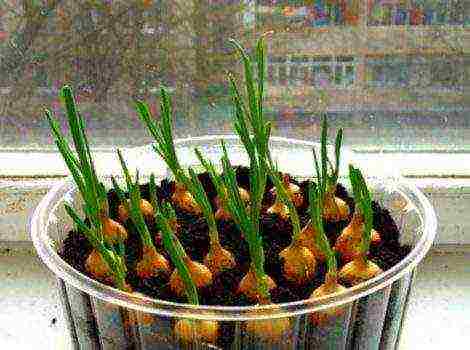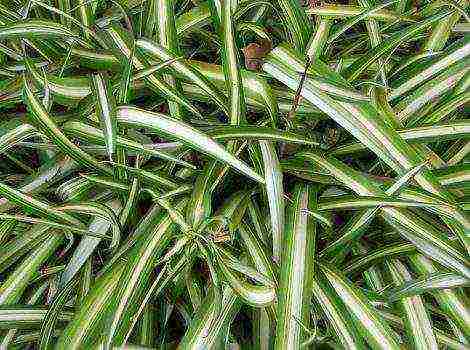Content [show]
Long gone are the days when the townspeople who did not have summer cottages were jealous of those who had them. Today, even a resident of a high-rise can afford to feast on fresh herbs and vegetables, using windows, balconies and loggias to grow them.
Today any non-lazy city dweller can please his family with fresh crispy greens by making the right choice of a variety of cucumbers for growing on a windowsill. The same goes for tomatoes, strawberries and peppers - modern breeders have specially created types of vegetables that can be grown in pots and get decent yields.
Characteristics of "home" cucumbers
In order to enjoy your own harvest of greens all year round, you should familiarize yourself in advance with what varieties of cucumbers exist for growing on the windowsill. They must have a different set of qualities than those that are sown in greenhouses or in the open field:
- First, it should be self-pollinated hybrids, so as not to waste time on manual pollination.
- Secondly, it is desirable that the plant be shade-loving, since not every window is suitable for it. In order not to additionally illuminate with lamps in winter, it is better to look in advance for varieties of cucumbers for growing on the windowsill, which easily tolerate a lack of light.
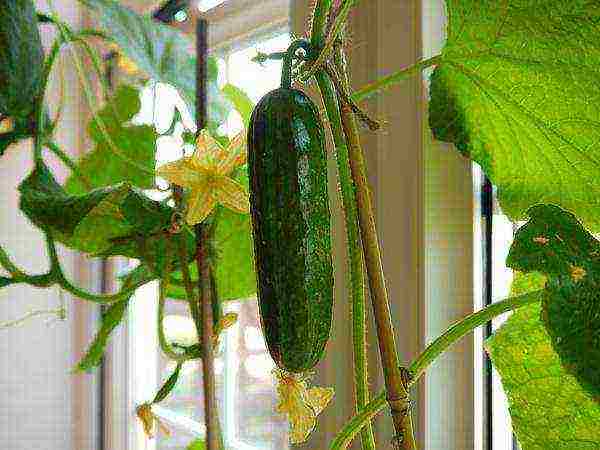
- Thirdly, it is preferable to purchase a frost-resistant variety, especially for planting on a balcony or loggia, where there is no additional heating.
If earlier varieties of cucumbers for growing on the windowsill of the house consisted of only one type - "room Rytov", today there are dozens of them. It is important to evaluate the conditions in which the vegetable will grow, and, based on them, to purchase the most suitable one, since the manufacturers indicate all the characteristics on the package.
Cucumbers for the windowsill
For many "home gardeners", a high yield is a top priority. In fact, it is more important that the plant grows strong and healthy in the conditions of a balcony or window, then the collection of fruits will become a pleasant experience. To date, the following are recognized the best varieties of cucumbers for growing on the windowsill:
- "Prestige f1" is a parthenocarpic species that bears fruit for a very long period. The first greens can be harvested within 40 days after seed germination. Cucumbers are 6-8 cm long and have excellent taste.
- Masha f1 is a very early ripening species that bears fruit on the 35-40th day. Also from the category "varieties of cucumbers for growing on the windowsill." Caring for him allows you to achieve the formation of up to 7 greens on one brush. Fruits are dark green with excellent taste.
- "Ant f1" is one of the most productive types of cucumbers. It is also parthenocarpic, ripens in bundles, in each of which up to 7 fruits are formed.
- "Balkonny" is a versatile variety that yields on the 41st day after seed germination. Relatively hardy, making it the best contender for growing on a glazed balcony. Productivity - up to 10 kg / m2.
When buying varieties of cucumbers for growing on the windowsill, you should definitely check that this property is indicated on the package. Also, all its qualities should be spelled out there - from yield and ripening terms to conditions for their ripening.
Selection of containers
Cucumbers love space, even when they grow in the garden, so you should take care of the container for them in advance. When choosing a container, it should be borne in mind that the optimal volume for one plant is 5 liters. These can be single ceramic pots or a one-piece long plastic container.
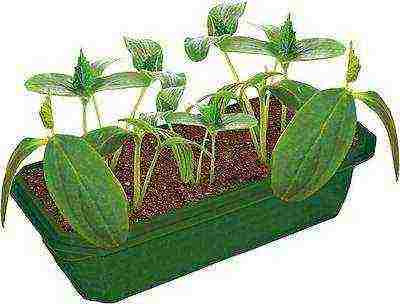
Some "home gardeners" adapt plastic five-liter water bottles, after cutting off their neck. You can also use heavy-duty plastic bags if you don't have another container on hand.
Some nuances should be taken into account when choosing a suitable container for any kind of cucumber for growing on a windowsill. The peculiarities of this plant are that it does not tolerate both dryness of the earth and stagnant water, therefore, there must be holes in the container for its drain.
If you fit the boxes for the "garden", then they must first be covered with dense cellophane, making holes at the bottom. Any of the listed containers will work well to grow and harvest a good harvest of cucumbers.
Soil preparation
For those who do not want to waste time preparing potting mix, ready-made, which is sold in specialized stores, is suitable. For those who want to personally participate in the process from start to finish, experienced gardeners recommend creating soil with their own hands. This will require:
- 1 part of garden or turf land;
- compost - 1 part;
- sand - 1/5 part;
- sawdust - 1/5;
- wood ash - 1/5.
To prevent the soil from harming the plants, it should be calcined, for which you can use a conventional oven. Ready and mixed soil is poured into a baking sheet in a layer of up to 5 cm and put for 20-30 minutes in an oven preheated to 100-110 degrees.
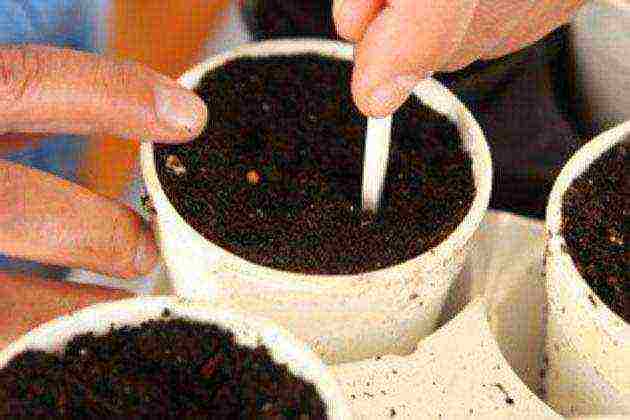
After calcining, the soil must be fertilized, for which it is enough to add mineral fertilizers for pumpkin seeds in a couple of matchboxes. Cucumber supplements are available for purchase. The prepared soil is packed in five-liter containers and thoroughly watered one day before sowing the seeds. Whatever varieties of cucumbers are used for growing on the windowsill, the preparation of the soil is the same.
Seat selection
An important role in a good harvest is played by where exactly the cucumbers will grow. This plant loves sunlight and warmth, so either it will be windows or a balcony on the south side, or a window sill warmed and equipped with phyto- or fluorescent lamps from the other side.
It must be remembered that the usual variety of cucumbers needs up to 12 hours of light for the seedlings to grow evenly. This is especially true for the period from November to the end of January. If seeds specially bred as shade-loving are used, then this period can be shortened.
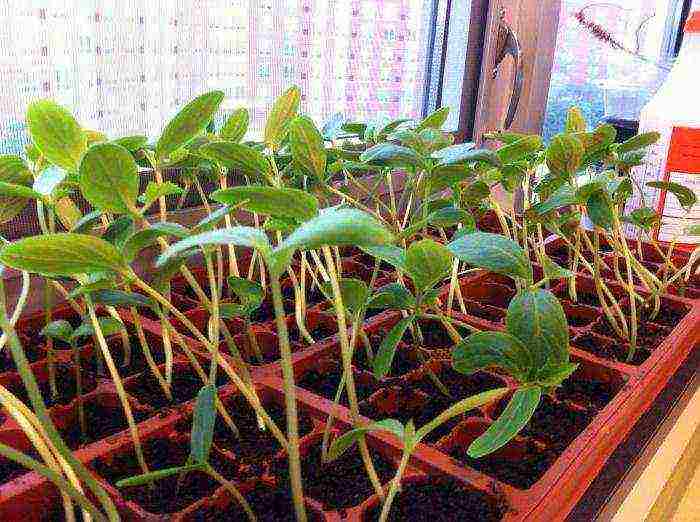
It is very important that the plant is not exposed to drafts when ventilated. It is necessary that the frame does not allow cold air to pass through. Some gardeners, even with high-quality glazing, use additional insulation or stretch plastic wrap between the plant and the window frame. It transmits sunlight well enough, but at the same time saves from the cold.
Every grower has little tricks to help the plant grow strong and healthy (for example, using mirrors or foil to reflect sunlight and increase lighting).It is also advisable not to put the pot directly on the windowsill, but it is better to put a layer of foam plastic or just wooden blocks under it. This is an additional measure to protect the cucumbers from the cold.
Seed preparation
To avoid further problems with the growth of seeds, it is better to prevent them. For this, a weak solution of potassium permanganate is used, in which the planting material is kept for a couple of hours. By the way, this is also a test of their quality - only those that have sunk to the bottom during a given time should be planted. Seeds floating on the surface will either not sprout at all, or will not yield a crop.
After potassium permanganate, the seeds must be left for a couple of days in a humid environment for germination. To do this, a gauze or natural fabric moistened with water is suitable, which must be sprayed as it dries.
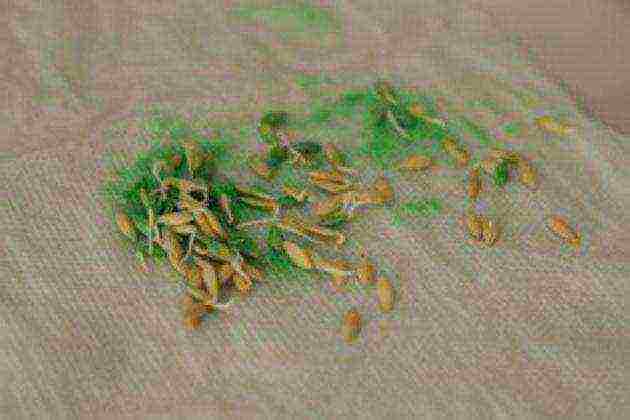
When the seeds "hatch", they can be planted in cups prepared for this. Some gardeners prefer to sow directly into pots, which saves them time, but it is important to cover such a container with a film until the first leaves appear on the seedlings.
Whatever the varieties of cucumbers for growing on the windowsill, in the first week before sprouting, they need to provide a temperature of + 22 ... + 24 degrees. After they rise, they can be transferred to a cooler place, where the air warms up to +18, but good lighting is provided.
Seedling care
In order to collect from 10 to 25 greens from each plant every day, it should be provided with appropriate care. For this:
- watering should be carried out daily, but care must be taken that the water does not stagnate;
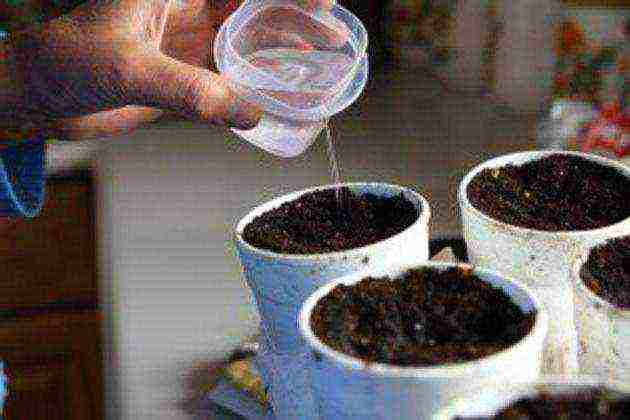
- it is necessary to provide the plant with appropriate moisture, for which it is enough to spray it from a spray bottle 1-2 times a day;
- if the plant is under artificial light, then watering can be done in the morning and evening.
To save time, some gardeners put trays of gravel under the seedling pots, where they pour water. This contributes to the constant moisture of the soil and air. In summer, the soil should be constantly wet, and in winter, watering can be reduced, but air humidity should be monitored at any time of the year.
Top dressing
To be healthy varieties of cucumbers for growing on the windowsill and picking fruits became a real holiday, they need to be fed with high quality. To do this, 2 weeks after the emergence of seedlings, it is required to make and add the first mineral solution:
- add 2 tsp for 3 liters of water. mineral fertilizer for cucumbers or pumpkin crops, water at the rate of 1-2 cups per 1 plant during the growth period and 3-4 - during fruiting.
- to extend the life of the plant, it is recommended to water it once every 2-3 weeks with a solution of 1 cap of "Growth" for 2 liters of water.
A good help is adding fresh vermicompost every 3-4 weeks.
Vine formation
In order for the stem of the plant to grow strong and bear fruit well, the first pinching of the top is carried out when 4-5 leaves appear. This will "provoke" the side branches to grow. When they give their shoots, the pinching is carried out over the third or fifth leaf. The mustache must also be removed, making sure that decay does not appear in their place.
When the main vine begins to rise, it should be tied up, for which you can insert sticks 1 m in length directly into the container with the plant or stretch the fishing line along the window. The liana needs to be pinned over the 11th or 12th sheet. When fruiting begins, it is necessary to ensure that the greens do not overripe. The more often the fruits are plucked, the higher the yield.
Sowing cucumbers in winter
The main distinguishing feature of any variety of cucumbers for growing in winter on a windowsill is the need for additional lighting. It is better if special phytolamps are used for this. The rest of the care conditions are simple:
- moderate watering;
- high air humidity, for which it is better to use containers with water or spray the plants several times a day;
- timely formation of the bush;
- daily harvest during the fruiting period.
Cucumbers need feeding in winter no less than at other times of the year. The size of the harvest directly depends on this. If the plant is "malnourished", then it will tell it by slow growth and yellowed greens.
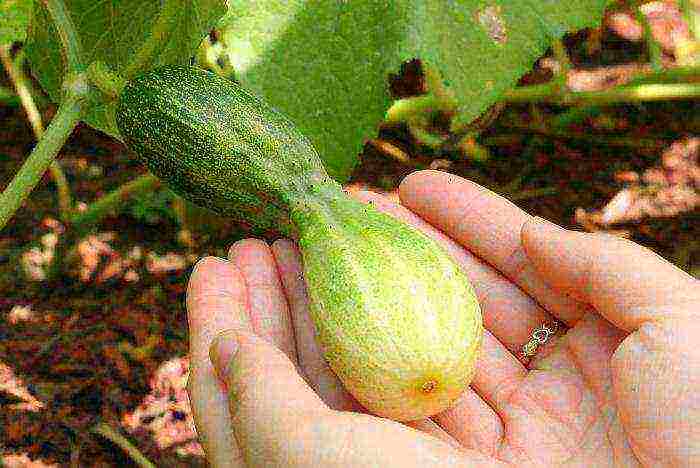
Sowing seeds can be carried out in any month, but at the same time take into account the temperature and illumination of the selected place. Since cucumbers can give a harvest in 4-5 weeks, their planting depends only on the preferences of the owner. For example, you can do this 5-6 weeks before New Year's holidays to delight guests with a fresh cucumber salad.
Sowing cucumbers in summer
If in winter it is important that there is additional lighting, then varieties of cucumbers for growing on a windowsill in summer do not need this. On the contrary, you can slightly shade the plants with a net if the south window is chosen. The main requirements for a good harvest during this period:
- frequent watering;
- regular spraying with water;
- timely harvest.
In general, growing cucumbers at any time of the year is not a burdensome task that brings joy to the harvest.
We are accustomed to the fact that fresh cucumbers "straight from the garden" can be enjoyed only in summer, and in winter we can only be content with cucumbers bought in stores. But after all, purchased vegetables are not nearly as tasty as home-grown vegetables. But resourceful gardeners have found a way, even in the cold season, to delight their households with fresh crispy cucumbers "right from the garden" - they grow them on their windowsills!
Cucumbers on the windowsill in winter: the best varieties
Such different varieties of cucumbers
Vegetables grown right in the apartment no longer seem like a wonder - more and more summer residents do not want to part with the juicy and tasty fruits for the winter, which they are used to during the summer season. Therefore, they begin to resort to various tricks, a kind of "life hacks", such as growing vegetables on the windowsill. Among those cultures that live well in a city apartment, cucumbers can be especially noted.
Cucumbers will not suffer much from a lack of sunlight in the apartment.
Why cucumbers?
- Firstly, these are shade-tolerant plants and they will not suffer much from the lack of sunlight in the apartment in the winter.
- Secondly, cucumbers are very convenient and efficient to contain: they will not take up much space, but you can pick up a variety with a high yield.
- Thirdly, cucumbers grow and ripen quickly - the crop from the bush can be harvested within 4-5 weeks from the moment of sowing.
But not every variety of cucumbers will have to live in an apartment to taste: some of them still prefer a greenhouse to a cozy window, and therefore will not be able to fully grow and bear fruit at home. How to choose a variety?
Not every variety of cucumbers will have to live in an apartment to taste.
First, let's find out what varieties are:
varieties that are not suitable for homemade preparations, but taste great when used raw. They make delicious and aromatic salads. They store very well, therefore they are often used for sale. Cucumber spines are white.
Attention: if the thorns on the body of a cucumber are white, then this is an excellent salad variety, but such cucumbers are not suitable for canning.
| Parthenocarpic | Varieties that do not require pollination. Produce fruit without seeds |
| Self-pollinating | Varieties that have both pistils and stamens in one flower. They pollinate on their own, while their fruits are with seeds |
| Bee-pollinated | Here, too, everything is clear from the name. In order for the ovary to appear, bees are needed to pollinate the flowers of the plant. Alas, insects are indispensable here |
| F1 hybrids | "Babies" of the first generation, obtained from crossing two different varieties. They are popular among gardeners because they have a bountiful harvest, good fruit taste, and tolerate fluctuations in growing conditions well. |
| Salad | |
| Salting | Varieties, the best use for which is the preparation of homemade preparations, since the peel of such fruits perfectly absorbs the brine. It is better to preserve them immediately after harvesting, since the keeping quality of such varieties is minimal. The thorns on the body of the fetus are black |
| Universal | Such cucumbers are suitable for everything: they can be salted, and pickled, and eaten raw. Their thorns are black |
Also, varieties of cucumbers are subdivided according to the type of conditions and place of cultivation (for indoor or open ground), according to the shape of the stem (liana, bush). They are also classified according to the size of the greenery (gherkins, pickles and others).
Zelenets is the name of the fruit of a cucumber.
Cucumber Zelenets F1
Choosing a variety
How to choose a variety of cucumbers to create a greenhouse on your windowsill? Everything is very simple:
- Cucumbers on the windowsill should take up as little space as possible so as not to interfere - that is, choose bush varieties, and not those that grow into a giant liana.
- Choose a variety with good yields so that it will bring more benefits (or rather, fruits) to the gardener.
- Choose varieties that are unpretentious to growing conditions: in winter, due to central heating, it can be very dry in apartments, and cucumbers love humidity. In addition, in the winter season, plants may experience a lack of light.
- Stop your choice on hybrids - such varieties bear fruit well and are tolerant of negative environmental influences.
The variety must be self-pollinated
The variety should be self-pollinated or parthenocarpic - won't you breed bees in winter so that they pollinate your plants?
Recommended varieties of cucumbers for growing on a windowsill
The following varieties of this herbaceous plant have already been tested by time, or rather, by summer residents.
| Window-balcony F1 | The name of the hybrid has already said everything about this variety - it was created specifically to settle in your window. The flowers are predominantly female. You can enjoy the first cucumbers already 55 days after the seedlings have sprung up. At the same time, the yield is quite high - up to 15 kg of cucumbers are removed from 1 square meter. Zelentsy are smooth, dark green, shiny, up to 16 cm long. Delicious fresh. A hybrid that is not afraid of diseases, shade-tolerant, easily tolerates temperature changes and does not lose ovaries | |
| Ekaterina F1 | A hybrid variety with the name that the great empress once bore. Medium early variety (ripening period about 50 days), bearing fruit for a long time. The bushes are medium in size, give green greens up to 23 cm long. The yield is good - about 18 kg of juicy cucumbers can be "removed" from 1 square meter. Low susceptible to diseases, frost-resistant, shade-tolerant hybrid variety. It is used for home canning, but it shows its best taste when consumed fresh. | |
| Gift of the East F1 | A mid-season hybrid that does not require pollination. Weak plant of medium size, bears fruit abundantly and for a long time, not susceptible to diseases. Produces fragrant, sturdy fruits of a modest size (up to 10 cm long) with a light downy. The yield is average - from 1 square meter you can collect up to 9 kg of cucumbers, which are well canned and no less wonderful in taste when eaten raw | |
| Faust F1 | Pollination-free, early maturing hybrid variety with female flowers. Fruits are medium in size, smooth in the form of a cylinder up to 18 cm long with a bright taste, do not taste bitter. Used for salads | |
| Zozulya F1 | A well-known old medium-branching hybrid variety for salad purposes. The yield is good. Begins to bear fruit early - already 45 days after the emergence of sprouts. Fruits are decorated with white thorns, large (up to 22 cm long), with white fluff, well stored. Relatively cold-resistant hybrid variety, not afraid of diseases and cold weather | |
| Hostess F1 | A frost-resistant medium early variety that does not need to be pollinated. Strongly branched plant, not limited in growth.Thorn cucumbers are suitable both for conservation and for eating raw. The size of the cucumbers is up to 15 cm, dense, lumpy, dark green fruits | |
| Shchedryk F1 | An early ripening, vigorous variety with an average level of climbing. Fruits with tubercles, not large, up to 12 cm long. The pulp is not bitter, dense, the skin is tender. The hybrid is not afraid of diseases, unpretentious. Zelentsy are used for making salads | |
| Masha F 1 | Parthenocarpic hybrid variety. The ripening time for zelents is about 45 days. Productive, not susceptible to disease. Cucumbers do not taste bitter, ripen early. They are canned and eaten raw. | |
| Onega F1 | Fast ripening (up to 38 days after sprouting), self-pollinated hybrid. Weakly branched, indeterminate. Cucumbers are small (up to 82 grams), striped, cylinder-shaped, with black fluff. Suitable for salting, pickling, making salads |
We grow cucumbers on the windowsill
Now, in order for the cucumbers to delight us with their fruits, their seeds need to be planted and grown. Having decided on the variety, we proceed to this important event.
- Let's start by preparing a container for plants and soil. Choose oblong boxes or pots for cucumbers at the rate of at least 5 liters by volume per plant. Make drain holes in each container.
- We prepare the soil: for this we mix in equal parts garden soil, sand, rotten sawdust, ash, humus. Put the prepared soil in the oven and warm it up to destroy insect eggs and infections in it. You can buy ready-made soil from the store.
- Pour soil into containers 24 hours before sowing and spill well.
- Make a depression in the ground (about 1.5 cm), place the seed there. We plant the prepared seeds either germinated or dry, as it is more convenient. Sprinkle with soil.
- We close the boxes or pots with cellophane wrap and place them in the room where the air temperature is at least +25 degrees. Can be placed over a heating radiator.
- We are waiting for the first shoots to appear. When the plants hatch, remove the cellophane and put the boxes with seedlings on the windowsill. The air temperature should now be around 20 degrees.
- When the plants grow a little, you need to shape them. To do this, when 4-5 leaves appear at the bushes, you need to start pinching the top so that the lateral branches-lashes go into growth (they are left about 2-3 per bush).
- Then the lashes will have to be pinched (this is done over the 10th leaf). According to this principle, the plant is formed further.
- Do not forget to tie up the whips so that the whole plant has enough light. The excess mustache is cut off.
Cucumber care
How to care for the cucumbers living on your windowsill so that they give you a bountiful harvest? Everything is simple here:
- Some varieties of cucumbers are tolerant of some shading, but it is still better to fully provide plants with life-giving light. Therefore, if you grow cucumbers on the window in winter, then from November to February, in the "darkest" months, additionally highlight the plants.
- Feed the cucumber bushes periodically with organic fertilizers.
- Cucumbers are often watered with warm, settled water - these plants love moisture. If the air in the house is dry, then saucers of water are placed near the plants to moisturize and the bushes are periodically sprayed.
- Cucumbers love warmth, and therefore do not put them in a cold room or in a room that is often ventilated.
- If the cucumbers began to bear fruit, then the harvest must be removed regularly, preferably daily, so that the bush does not waste energy on ripe fruits and form new ones, delighting you with fresh cucumbers for as long as possible.
A good fertilizer is a fermented infusion of banana skins diluted with water.
Video - Planting cucumber seeds
Fresh vegetables in the cold season will be a pleasant and healthy addition to your daily diet.For this, it is not necessary to buy imported products in the nearest supermarket; it is quite possible to organize a mini garden in your own apartment.
In order for the cultivation of cucumbers at home on the windowsill in winter to be crowned with a good harvest, you should select special, parthenocarpic hybrids - varieties that do not need pollination. Each of them has its own negative and positive qualities, knowing which it is easier to achieve the desired result.
Shchedryk
This variety is specially designed for this type of cultivation. The first crop of full-fledged green fruits up to 15 cm long can be obtained 45 days after planting the seeds.
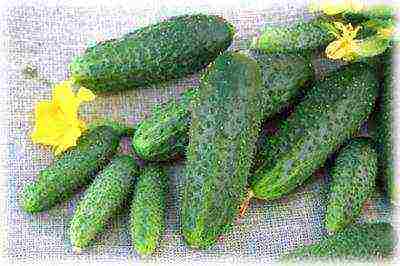
"Shchedryk" is not demanding on light, therefore it is ideal for windows facing the north side of the house. With regular watering and observing the temperature regime, one bush gives up to 20 fruits per season.
Rytov's indoor cucumbers
The best variety of cucumbers for growing on a windowsill in winter, specially bred.
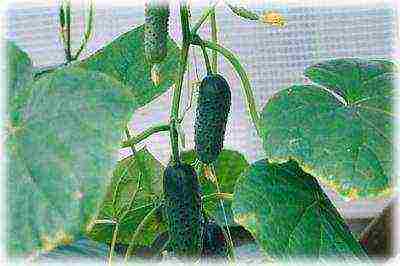 High-yielding, bushy, does not require a special garter and additional lighting with a short daylight hours. Demanding for heat and watering, responds well to fertilizing with mineral fertilizers.
High-yielding, bushy, does not require a special garter and additional lighting with a short daylight hours. Demanding for heat and watering, responds well to fertilizing with mineral fertilizers.
Zozulya
The F1 hybrid, relatively young and not very well-known, has proven itself well among indoor-scale gardeners due to the following qualities:
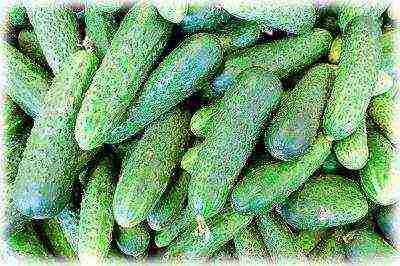
- self-pollinating;
- high-yielding;
- resistant to the most common diseases;
- suitable both for fresh consumption and for salting.
The main disadvantages of the variety can be attributed to its photophilousness, therefore, when planting on a shaded window sill, the daylight hours should be increased with the help of lamps.
Russian winter
The variety was bred in 2013, based on the Klin varieties of the plant, glorious since the time of Tsarist Russia for increased disease resistance.
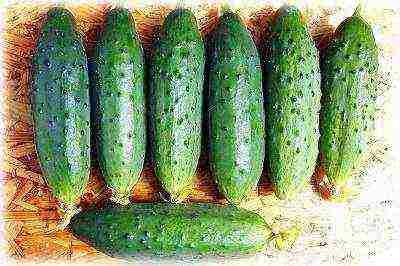
They have remarkable qualities characteristic of the main variety:
- shade resistance;
- low branching;
- good marketability and taste.
Unlike other varieties, it has pimpled fruits with faint whitish stripes.
Brownie Kuzya
The varieties of cucumbers for growing on the windowsill in winter, selected taking into account the peculiarities of indoor cultivation, differ significantly from the types of plants intended for open ground.
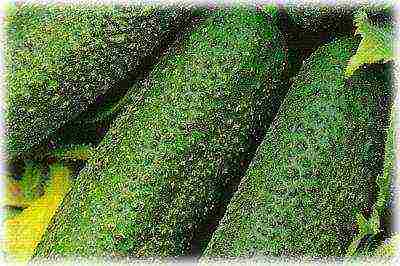
This variety is noted by many amateurs for the following qualities:
- low requirements for lighting;
- resistance to temperature extremes in the room;
- fertility - 2-3 bushes give up to 10 kg of full-weight products per season;
- taste qualities.
Loves watering with warm water and loose soil. It is good both fresh and as light-salted billet.
Mashenka
It belongs to the earliest hybrids. The first crop in the amount of 5-6 medium-sized greens can be obtained one month after germination.

Advantages:
- does not outgrow;
- bears fruit well in indoor conditions;
- resistant to powdery mildew.
Flaws:
- needs additional lighting in the winter;
- picky about feeding;
- lashes grow strongly, so large windows should be chosen for growing.
The variety responds best to watering with organic fertilizers - for example, a manure solution prepared at a rate of 1:10.
Khrustyk
A relatively young hybrid, equally suitable for a greenhouse and for growing cucumbers on a windowsill in winter.
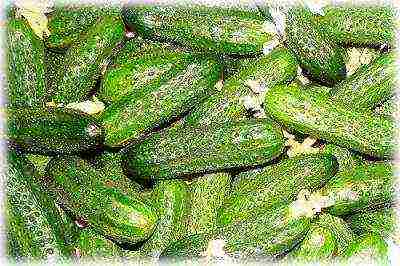
A distinctive feature of the variety is its high yield and excellent taste of the fruit - the characteristic bitterness is removed from the zelents at the genetic level. Of the shortcomings, it should be noted a strong branching and tall stature - 2-3 bushes on the windowsills are able to completely shade the room.
City gherkin
A mid-season gherkin that tolerates well the lack of light in winter.
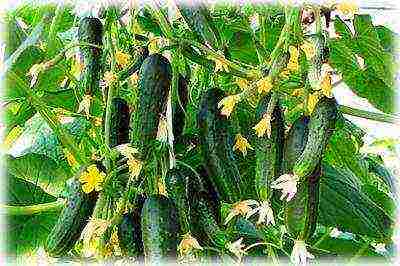 Differs in special productivity and resistance to powdery mildew and olive spot.Several bushes, planted on the windowsill, are capable of producing up to 20 kg of full-bodied pimpled fruits with a thin skin and good density in a short time.
Differs in special productivity and resistance to powdery mildew and olive spot.Several bushes, planted on the windowsill, are capable of producing up to 20 kg of full-bodied pimpled fruits with a thin skin and good density in a short time.
Enduro F1
An excellent variety, of Dutch origin, it makes growing cucumbers on the windowsill very exciting and profitable in winter.
It is prone to tuft of ovaries, which allows you to get high yields in a small area, tolerates temperature drops and low air humidity well. Subject to all the rules of agricultural technology, the fruits grow up to 40 centimeters in length.
Moscow greenhouse F1
One of the oldest hybrids, bred in Soviet times, is distinguished by its large fruit size and good resistance to various diseases.
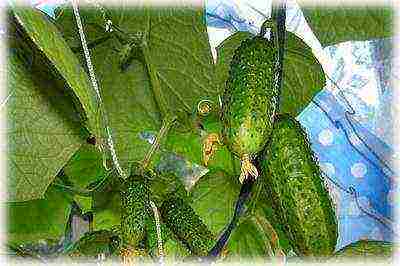 With regular watering with warm water and fertilizing with mineral fertilizers, it gives up to 15 kg of high-quality salad products.
With regular watering with warm water and fertilizing with mineral fertilizers, it gives up to 15 kg of high-quality salad products.
Alternative type of container
In order to use the entire window sill space as efficiently as possible, containers should be used that allow the bushes to be placed close to each other without damage to the root system. Growing cucumbers on a windowsill in winter in a package is a great replacement for bulky wooden boxes or buckets.
For this purpose, only dense polyethylene products with a capacity of at least 5 liters should be used. It is imperative to install a pallet under the mini-bed, where excess moisture will be collected, flowing from the drainage holes located at the bottom of the bag. Caring for plants in such a container is identical to the generally accepted one used for bushes planted in rigid containers.
VIDEO: how to grow cucumbers on the windowsill?
This video tells about the principles of planting and growing cucumbers on the windowsill, common to all varieties:
Felix
0 0
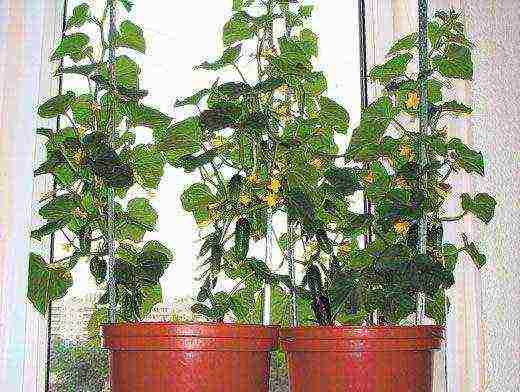
If you like gardening, then growing cucumbers in an apartment is for you.
Greetings, my dear readers!
In urban settings, we eat only those vegetables that we buy in the market and in the store. However, those who have a persistent desire to treat themselves and their homemade fresh products "just from the garden", and in the metropolis will find the opportunity to grow cucumbers on the window with their own hands.
They can also be dropped off on the loggia / balcony. At the same time, materially, you will receive a good harvest of vegetables, and spiritually - the joy of interacting with living plants.
Term number 1: optimal conditions for the success of the enterprise
For your attempt at gardening to be successful, you must take into account those special conditions that develop on the balcony.
Location of the "vegetable garden"

The balcony or loggia should be glazed and located on the sunny side of the house.
Not any loggia or balcony is suitable for growing cucumbers.
- The most important condition for this agriculture to develop, grow and bear fruit without problems is a constant temperature regime. During the day - over +18 degrees, at night - more than +15 degrees.
- Cucumbers do not tolerate drafts. With a high degree of probability, you will not harvest a more or less decent crop on a balcony that is not protected from the wind.
- This southern culture is very fond of light. Even by equipping additional lighting, you are unlikely to achieve acceptable fruiting, in the case when the loggia (balcony) is located on the north or west side of the building.
Based on the foregoing, cucumbers should be grown with their own hands on a necessarily glazed balcony. In addition, it should be well lit by the rays of the sun and located on the south, southeast or east side of the house.
If you manage to make the most of the sunlight and heat on the loggia, you can safely start choosing seeds.
What varieties are suitable
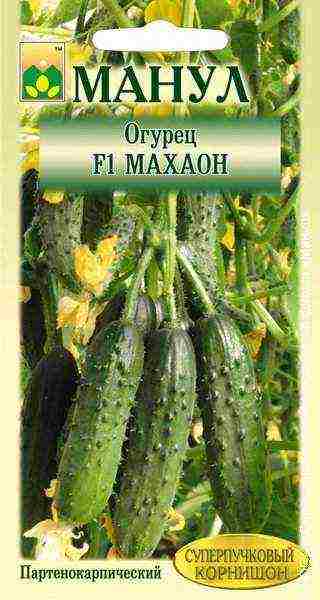
Varietal type "Balcony" is best suited for growing in an apartment.
Loggia and balcony are very limited.
- Based on this, hybrid cucumbers with a compact habit: short internodes and small leaves are optimally suited for growing on them.
- The branching of plants does not matter: it can be strong or weak.
- It is best to choose non-bush, that is, tall varieties of vegetables.
- With low soil and air humidity, as well as insufficient illumination, shade-tolerant and drought-resistant cucumbers, having a powerful root system, grow better than others.
There are now many varieties of seeds on the market that are specifically designed for balcony germination.
When choosing seeds, carefully read their label. It should be written there that the variety is hybrid, shade-tolerant, has small fruits, does not need pollination and can be grown in a balcony.
So, at the moment, agricultural breeders have bred a group of special varieties of cucumbers, they bear the general name "Balkonny". It includes such hybrids:
- F-1 "City Gherkin";
- F-1 "Balcony";
- F-1 Berendey;
- F-1 Machaon;
- F-1 Calendar;
- F-1 "Balagan";
- F-1 Courage;
- F-1 "Hummingbird", etc.

It is best to grow cucumbers on the loggia that do not require pollination.
In addition to these analogues, there are other varieties of cucumbers for the balcony, well adapted to indoor, not capricious and stable. For indoor planting, it is best to choose parthenocarpic hybrids (not requiring pollination), For example: Barnaulets, Balcony Miracle, Dragonfly, Matrix, Parus, Dubrovsky.
Analogs "Zozulya", "Cucaracha" and "April" can bear fruit without pollination by bees. However, nothing terrible will happen if insects take part in their fertilization.
- If you prefer pollinated window-balcony varieties of cucumbers, choose the hybrids Ladoga, Olympiada, Fregat, Gribovsky. Please note that when they bloom, you will have to attend to artificial pollination.
- For male flowers, plant the Ermine or Hercules varieties. They have combined colors. Due to this, they can be used as pollinators and independent hybrids.
- For fertilization, the instruction prescribes cutting off the male color (with stamens) and applying it to the female counterpart (with a pestle). In this case, pollen from the stamens will fall into the pistil. If you do not, then the female color will not form an ovary, but will simply disappear.
This is how the "F-1" seeds are obtained.
I would like to separately mention for you the mysterious labeling of F-1 varieties. It means that these are the seeds of hybrid cucumbers. To grow such a crop, agricultural technicians cross 2 different varieties of vegetables.
The seeds collected in the end are hybrids in the first generation. This is what the “F-1” marking (letter “F” is an abbreviation for the Italian word “filli”, that is, “children”, and the number “1” means the first generation).
I want to warn you right away that the main disadvantage of such hybrid cucumbers is the fact that it is useless to collect seeds from them. They are not viable and simply will not germinate.
What to grow
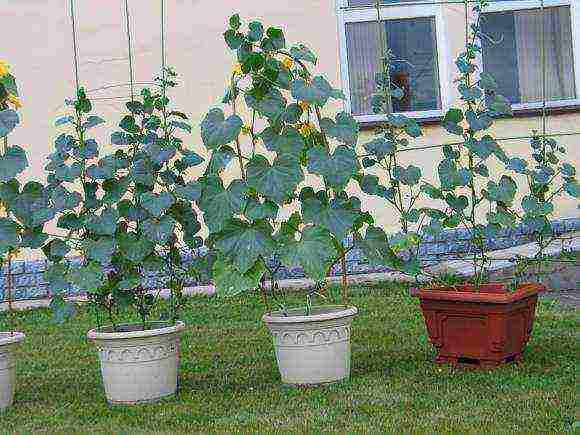
Most often, cucumbers are grown in pots and flowerpots.
Planting of cucumber seeds is carried out from the second half of April to the beginning of May. If you do this earlier, then the buds will appear prematurely - before the cucumbers can be placed on the balcony. There will be a risk of the ovaries falling off. In addition, due to insufficient light, the lianas will grow too actively.
For growing cucumbers, you can use a variety of containers: plastic containers for flowers, pots, flowerpots and even double bags made of polyethylene (tucking the edges at the bottom). The best option if the containers will have a double bottom. In the upper of them there will be drainage holes for the drain of excess water, and the lower one will play the role of a sump.
I warn you that cucumbers love water, therefore, they should be watered in abundance. In the course of the growth of the lashes, their roots will reach through the holes in the upper bottom into the lower bottom. From there they will actively "drink" water on hot days.
At the same time, the soil will not be waterlogged. This is important because the roots of cucumbers do not tolerate excess soil water, it interferes with their breathing.
Soil composition
The soil should be structured and loose.
Fill the seed containers with soil before planting. Do this without filling about 5 cm to their top. During the growing season, the soil will settle, and you will add it to the desired level.
The volume of soil per plant should be at least 5 liters. Otherwise, it will dry out during fruiting.
- Any well-structured and loose soil is suitable for cucumbers, but not dense clay or podzolic sod soil. Compost, lowland or high moor peat, as well as various soil-peat mixtures are also suitable.
- The acidity of the substrate should be 6.6-6.8 pH (from its aqueous extract). This indicator can be found using the acidity determinant (pH meter). You can buy it at a hardware store.
- In the case when the soil is acidic, it should be limed. To do this, add dolomite flour, lime or finely ground chalk to it. The consumption rates of dolomite powder per 10 liters of peat: if it is low-lying, then 10 grams, transitional - 15-20, high-moor - 20-30.
- Soil substrates, which contain only a fraction of peat or it is absent altogether, have different levels of acidity.
- When the acidity of the aqueous extract is 6.2-6.5 pH per 10 liters of soil, 5-10 grams of dolomite powder must be added. The rate of adding lime and chalk is 3-7 grams.
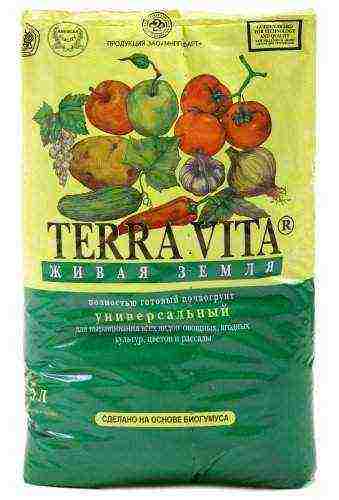
It is best to purchase a ready-made soil substrate.
The best option for a novice balcony gardener is to use a ready-made soil substrate. Such soil is sold in stores already filled with fertilizers and limed. The price of such a substrate is low. Moisture-retaining additives (eg agrotechnical gel) can be added to it.
Term number 2: cultivation techniques
Basic agricultural techniques.
When growing cucumbers at home, carefully follow all agrotechnical requirements. There should be no trifles here.
Seed preparation
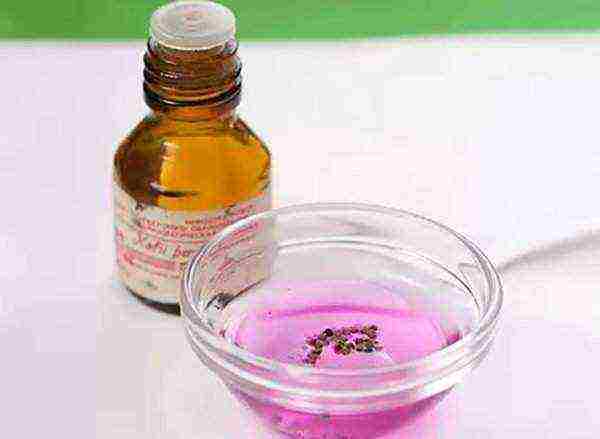
Disinfection of seeds with potassium permanganate.
- If the seeds you purchased have a colored shell, then they can not be treated against harmful microorganisms.
- Otherwise, they should be disinfected in order to prevent various diseases. Dip the seeds for 15-20 minutes in a weak solution of potassium permanganate (1 g of potassium permanganate per 100 ml of water). Then rinse them with running water.
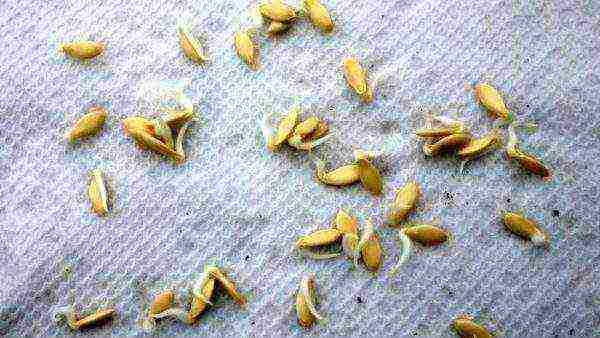
The photo shows germinated seeds.
- Then you can start germinating the seeds. Wrap them in cheesecloth and keep it slightly damp. After two days, the seeds will hatch.
I want to warn you about one of my curious agrotechnical experiments: germinated seeds were placed in 5 seedling cups, and not germinated in 5 other containers. The result of the experiment was that in the cups with non-sprouted seeds, the sprouts hatched a day later than with sprouted seeds.
And one more important circumstance that I realized: do not neglect sprouting when preparing cucumber seeds. You can run into a dissimilar "embryo" (for example, an F-1 hybrid) and then you will be wasting your time. I did just that - out of five seeds, two were not viable.
How to grow seedlings
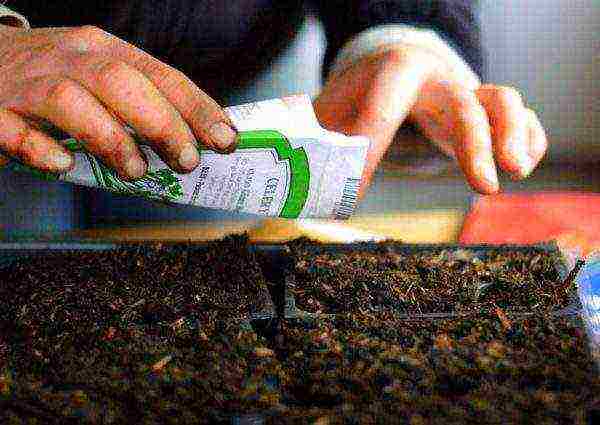
Planting seeds.
Prepared seeds can be planted in a flower container. Make holes along its middle line (2 cm deep and 40 cm increments). For insurance, you can plant two seeds in each hole.
Cover the sowing with plastic wrap and put it in a well-lit place. The best option is if it is a warm windowsill.
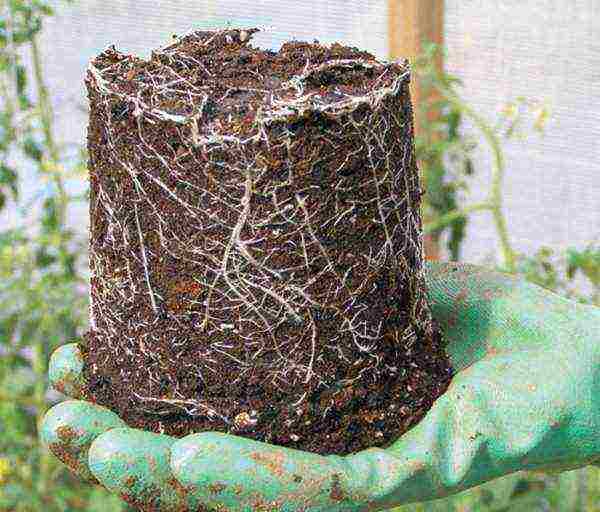
When removing seedlings, it should firmly braid the soil with roots.
The best volume of seedling containers is 200-300 milliliters. If it is larger, the lump of soil will crumble when the cucumbers are transplanted to a permanent place. In other words, the roots will not be able to braid the soil tightly. With smaller dimensions, the soil will dry out quickly.
- Therefore, it is convenient to plant seeds for seedlings in disposable cups. Growing in plastic bottles with cut necks is also popular.
- As I already wrote, you can buy soil substrate in the store or prepare it yourself. For example, mixing wood dust, peat, humus and earth in equal proportions.
- Fill the soil with fertilizer: add a glass of ash (200 g) to its bucket (10 l), two teaspoons of nitrophosphate and a teaspoon of urea.
- Before planting seeds, disinfect the containers: rinse with a weak solution of potassium permanganate or hold over steam.
- Punch holes in the bottoms of the cups so that the water does not stagnate in them. Then fill them with substrate and plant seeds in each container to a depth of 1.5-2 cm.
The optimum temperature regime for germinating cucumber seeds is + 24 / + 26˚.

On an open balcony, it is better to plant seedlings in a permanent place.
- When the weather is stable and warm in spring, on open balconies / loggias, you can apply both the seedless method (direct sowing of germinated or dry seeds into permanent containers) and seedling.
- If the weather is cool and unstable, seedlings should be planted.
- In the middle zone of the Russian Federation, cucumber seedlings are planted on open loggias / balconies from about May 10, if they are glazed - from the end of April. Planting should be completed by the second decade of June.
- The best home seedlings are those with two or three true leaves and a not yet elongated hypocotyl (the area of the stem from the ground level to the cotyledons). Older plants will take less root.

Seedling growth.
When sprouts hatch in the containers, they should be provided with sufficient lighting. From their appearance to the formation of two or three true leaves in ordinary varieties of cucumbers, it takes from 10 to 20 days.
Growing seedlings of the varietal group of hybrids "Balkonny" has its own characteristics.
- In ordinary cucumbers, the seedlings begin to outgrow and lie on their side in the phase of 5-6 true leaves (then the first tendril is formed).
- Balcony hybrids have small leaves and a sturdy stem. Thanks to this, "adolescents" stand upright and at the age of 6-8 true leaves.
- Therefore, you can plant in a permanent place and more mature cucumbers of the varietal group "Balkonny" without deteriorating their survival rate. So you will contribute to a stronger run of seedlings in development and speed up the beginning of fruiting.
- So, keep in mind - if there is a prolonged cool weather, then the age of the hybrid seedlings can be safely brought to 6 real leaves (this is 25-30 days).
About temperature
The temperature regime for the cultivation of cucumbers.
- When germinating seeds, the ambient temperature should be + 24-26 degrees.
- When sprouts appear, maintain the air temperature: + 20-24 degrees during the day, 18-19 at night, and the soil temperature + 20-24. A hotter ambient temperature will result in excessive stretching of the seedlings.
- After 4-5 days, you can increase the air temperature during the day in sunny weather up to + 24-26 degrees, if it is cloudy - up to + 20-24 degrees. Bring it to + 19-21 degrees at night.
- The temperature of the seedling soil should not be less than + 18-20 degrees. Otherwise, the cucumbers will grow slowly and be weak. Another reason why seedlings do not grow is that the leaves of neighboring shoots should not shade each other.
It is quite difficult to regulate the temperature regime on the balcony. As a result, it will be easier for you to move the shoots from it to the room and vice versa. This will help you achieve the desired temperature. For example, choosing the most illuminated area during the day.
We feed and water the sprouts

It will be pleasant to water the sprouts also for the younger members of the family.
In addition to the main fertilization of the seedling substrate, the sprouts should be fed. This is done 2 times.
- The first feeding is done a couple of weeks after the sprouts appear (the phase of two true leaves).
- The second is carried out after another seven days (the age of three true sheets).
About how to feed the seedlings of cucumbers on the window.
- For this you can take any complex mineral fertilizer dissolved in water (concentration 2-3 g per 1 liter of water).
- A nutrient mixture can be prepared by stirring about a tablespoon of urea in 6 liters of water.
- They feed the seedlings under the roots with it until the seedling container is completely moistened (about one glass of the nutrient solution).
Cucumbers love water very much. Watering their sprouts should be every day. In this case, the water must be settled and have room temperature. When the seedlings are additionally illuminated, they should be watered 2 times a day.
Term number 3: transfer to a permanent place
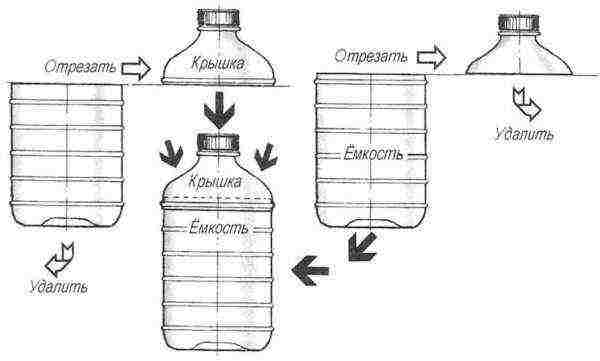
5 liter water bottles in coolers are best for cucumbers.
The signal for transplanting sprouts to a permanent place is the formation of 3-6 (depending on the variety) true leaves in them.
- Containers for growing vegetables should have a volume of 5-8 liters. You can use 5-liter cropped plastic water jugs, flower containers and crates, ceramic pots and vases, or plastic bags. The containers should be equipped with holes for moisture drainage.
- Pour drainage from small expanded clay, brick chips or crushed stone on the bottoms of the container.
- Fill the containers with the same potting soil you used for the seedlings. Do it not to the top. Leave 4-5 cm from the top of the container free. When the roots become bare during the growth of cucumbers, you can fill up the soil.
- Immediately before planting seedlings, disinfect the substrate by watering it with a solution of potassium permanganate.
- Remove the seedlings from the cups together with the soil clod and plant them in "adult" pots.
Plant care
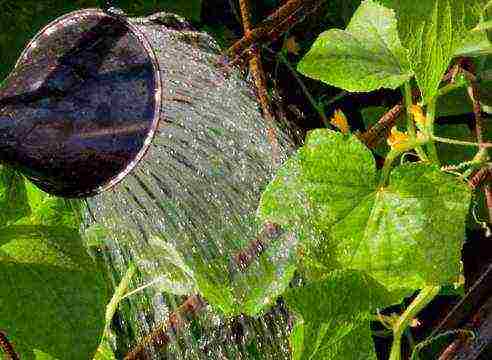
Water the plants daily.
Now about how to care for growing cucumbers. This task mainly consists in watering them in a timely manner. Your wards should not experience a lack of water.
- It is not only the soil that should be moistened, but the air too.
- To this end, place a container with water (bucket, basin) on the loggia / balcony and top up it regularly.
- In the evening, give the plants a “shower” - spray them with water from a spray bottle.
- In addition, add moisture to the lower pan. It will be drunk from there by the roots that have sprouted through the drainage holes.
- With high humidity, you can water cucumbers two to three times a week. In dry climates, daily.
- Water must be used at room temperature and previously settled.
In case of excessively hot weather outside (more than + 30˚), protect the cucumber leaves from direct sunlight, otherwise they will burn.
At nights in August it is already cool for southern plants. Wrap containers with burlap in the evening. This will help relieve hypothermia from the roots.
And finally - in the process of growing cucumber vines, change the points of their tying.
Tying whips
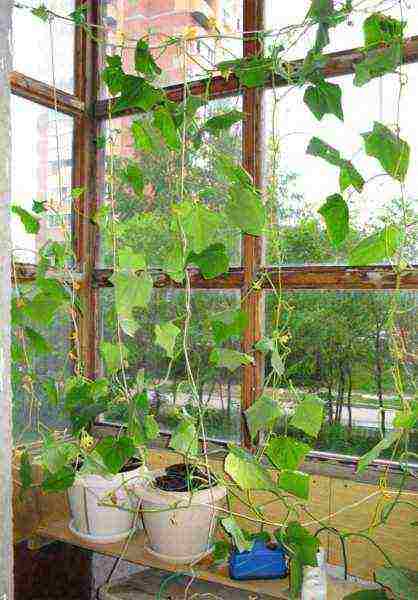
Tying vines with twines to the trellis.
Before growing cucumbers, keep in mind that they are, in fact, a vine. Based on this, her lashes should be tied up:
- Each liana, in the process of its growth, is twisted around a vertically stretched twine, fixed on top to a stationary support (trellis). It is usually a rigid, horizontally stretched wire.
- Stationary supports are stretched along the wall or along the sides of the loggia / balcony. In small rooms, the trellis wire is placed at the level of the arm raised up - this is 2.1-2.2 meters.
When containers with growing cucumbers are placed not on the balcony floor, but on supports (for example, on pedestals), the distance from the soil level to the trellis is reduced. This will negatively affect your harvest as the number of stem nodes will be less.
- Proceeding from this, when the lianas lianas in the process of growth "crawl" close to the support wire, carry out the reception of agricultural technicians "lowering the twine". Untie all the strings from the trellis, lower the pots from the pedestals to the floor of the room, lengthen the strings and tie them to the supporting wire again.
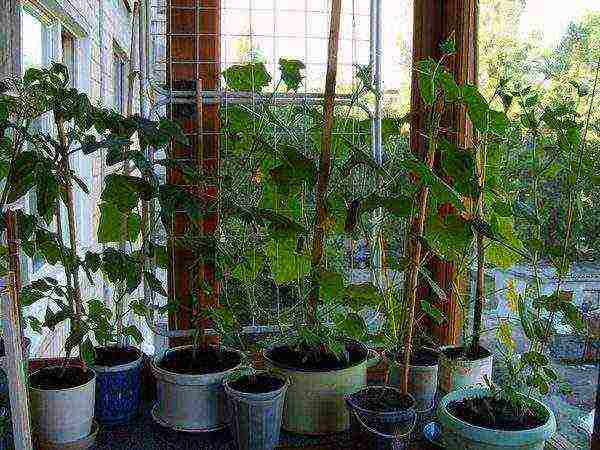
Cucumbers on rigid mobile supports made of wooden slats.
- You may have difficulties with the arrangement of stationary balcony tapestries.Then you can use another cultivation technique, providing mobile supports for cucumber vines. Then, in each container, fix a vertically located rigid support. The vines of cucumbers will curl along it.
- The third method of growing cucumber lashes on a loggia / balcony is to use pots. That is, in baskets or pots suspended from the ceiling.
Pinching vines
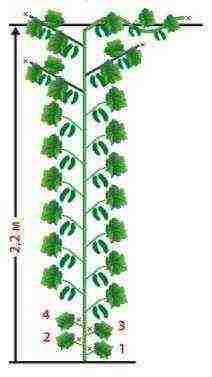
Pinching the plant.
Most of the hybrid cucumbers of the Balkonny cultivar type have abundant branching and do not grow much in length. Therefore, they are ampelous plants. That is, you can not pinch them or pinch only the growing tips of the shoots. Fruit set with this method remains high.
- But when the lashes are excessively hitting in growth, at the age of 10-12 leaves they should be pinched.
- Form, if possible, the vines of the cucumbers into one whip (stem). To this end, regularly break off the antennae on them.
- When to pinch. The main lash should be shortened when it reaches the full height that the balcony conditions allow. For example, it will reach the trellis.
- The shoots on the sides must be cut off so that the excess volume of green mass does not take away the vitality of the vine. They will be needed for the formation and ripening of fruits.
- Tear off other shoots or cut off above the ovary. Leave one sheet at the same time.
Top dressing of adult plants
Growing cucumbers on a window requires regular feeding. This is especially necessary for plants when they begin to bear fruit. Feed the cucumbers with mineral fertilizers every 7-10 days.
- Start feeding the cucumbers after 2 weeks, as the sprouts appear. For them, use the following nutrient solution: for 10 liters of pure water, 15 g of potassium, 5 g of ammonium nitrate, 3 g of superphosphate and 5 g of magnesium. Water the plants with fertilizer so that it does not fall on the leaves.
- For adult plants, use a different fertilizer: take an aqueous solution of mullein (ratio 1:10) and stir 15 g of potassium sulfate and 20 g of superphosphate in it.
- Cucumbers also love natural nutrition: infusion of tea or egg shells, wood ash.
About pests and their destruction
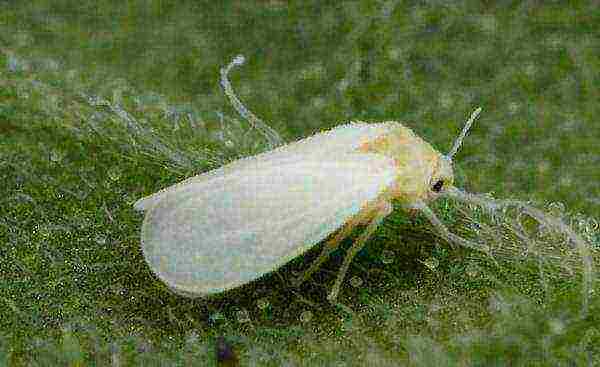
Whiteflies love cucumbers the most.
Not only we love fresh cucumbers. Prepare to be attacked by various insect pests. Having identified the enemy, start fighting with him. In this case, it is better not to use chemicals.
Here are the most common cucumber lovers and how to deal with them.
- Aphid. To get rid of it will help tobacco broth. Gut 20 cigarettes and fill them with one liter of water, put on fire. Bring the product to a boil and boil for 10 minutes. Then add another 1 liter of water to the composition. When it cools down, put it in a spray bottle and spray it over the cucumber leaves.
- Whitefly. It can be destroyed by the same tobacco broth, however, stronger (30 cigarettes per 1 liter of water). You can collect the pest from the leaves and with a vacuum cleaner operating at low power.
- Spider mite. Garlic tincture will help to destroy it. Chop a head of garlic in 1 liter of water. Insist the mixture for 1.5-2 hours. Then strain the tincture and dissolve 15 g of laundry soap in it. Next, fill the composition into a spray bottle and spray the affected plants with it.
What to do in winter
Growing cucumbers in the winter on the loggia / balcony is also possible. However, keep in mind some points here.
Heating dries up the air, which is harmful to plants. Based on this, you will have to additionally humidify the air in winter.
- Place trays filled with gravel under the vines and moisten it periodically.
- Use a humidifier.
- Place wet gauze on the radiator and moisten it regularly.
In the winter season, cucumbers can only be grown on the loggia / balcony if they are glazed, heated and well insulated. A water heating radiator or an installed electric heater will help to ensure a constant temperature of + 24-26˚ there. Do not forget to insulate the balcony windows for the winter, and tighten the vents with polyethylene.
Indoors, cucumbers often lack natural light, especially during the winter months. This can be seen from the fact that their leaves turn yellow.
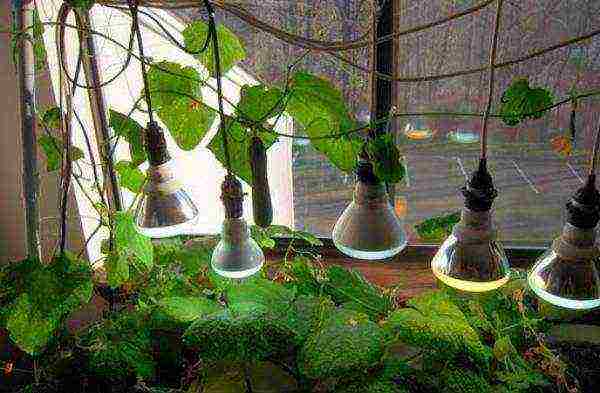
Highlighting sprouts.
- Therefore, when the seedlings hatch, so that they do not weaken, it should be additionally illuminated from 8 am to 4 pm.
- The optimal solution is to use special phyto-lamps for this. However, ordinary luminescent counterparts can also be used.
- Hang the lamps over the seedlings at a distance of about 15 cm. Having transplanted the sprouts to a permanent place, move the lamps as they grow, maintaining the sounded distance.
- Starting in March, 4 hours of additional illumination will be enough for cucumbers.
About the cycle of cucumbers in nature
The fruiting period for balcony hybrids lasts about 3 months. When it's over, cut the lianas and dig out the roots of the plants.
Shake the remaining soil out of the containers into plastic bags. You can apply this soil next year as a base, supplementing it with the same volume of new substrate.
Do not throw away cucumber containers, twine and trellis. All this will come in handy in the coming season.
Conclusion

Self-grown cucumbers - why not a reason for joy?
Growing cucumbers on the window is an entertaining and easy task. If you do everything correctly, you can collect up to 30 fresh, environmentally friendly cucumbers from each of your wards during the fruiting period.
The video in this article will help you learn a lot more interesting things. If you do not understand something, ask your questions in the comments.
Hereby I say goodbye, and success in your endeavors!
October 12, 2016
If you want to express gratitude, add clarification or objection, ask the author something - add a comment or say thank you!
